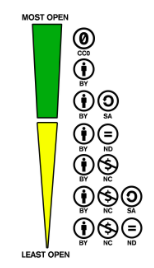Your creation
I never think about protecting my ideas in a formal and legal way and I am happy to share my work with all. While writting this senstence, I look at the signature of the painting on my wall. I am pretty sure that this artist is also very happy to share his work with all (but only the visual part). After all, he signs everything he does and this is why we attribute him a credit. There are few ways to protect your intellectual property, but do we actually know about them.
The intellectual property
The Gouvernment of Canada promotes few ways to protect you intellectural property. Perhaps, many of them are per country. That means that if you protect yourself in Canada nobody can copywright only in Canada. Often you need to protect in other countries too to make sure knowbody can steal your idea.
- Patent: Is used generaly to protect a invention, a technology or even a industrial workflow for exemple.
- Industrial drawings: This kind of protection can be use to protect a shape, a texture, a configuration, etc. You do a technical drawing and than knowbody can copy
- Integrate circut topography: Can protect the configuration tridimentional of a electronic circut
- Copywright: Use generaly to protect arts like painting, theater, music and books. Everyone who want to take a part to modify it need to ask your permission.
- Trademark: What's make you distinktive? If you create a distinctive publicity, song, color signature, logos, a special shape or sentence, etc.
- Industrial secret: protect unique informations like recepies or R&D research for exemples.
The Creative Commons


The Creative Commons is a licence that allows you legally to share the total or a part of your knowledge and creativity. I have seen the Creative commons logo a little bit everywhere, but I never searched and tried to understand. After few search I was happily surprise. It's very clever and smart, thanks to Lawrence Lessig, Hal Abelson and Eric Eldred to have starting this. Their main goal was to contribute to the "expension of "reasonable", flexible copyright". That means that you can put your condition of sharing. People can be inspired, take a piece or reproduce it (as you wish) but you will have the credit to be the original creator.
What is also very unique about it is that is free AND this service is made for normal humain. Legal protection needs to have a special vocabulary that the people who are not in the field can understand well. This is why they made the Creative Common in 3 layers. On layer for the legal aspect, on top of it you have the version for normal human with is a vulgarization of the legal aspect and third you have a part for the software which now can be understandible by a search engine or software or other technology. They integrated a code in the license that can keep the information. This Creative Commons page can give you more informations on this licences.
How to
1-Create a Creative Commons for a project
- Go on Creative Commons to create your licence and fill the form. If you have questions on the part you are filling, you have the ? icon that you can click and have more information.
- Depending on what you chose it will show you in real time the logo representing your choice.
- It's a internation licence
- You have a section to fill to add more numeric tracability.
- I create one for my final project the Canary.
What the formular looks like



When you have finish to fill the formular, they give you a code to integrate in you webpage.

Canary project de Annie Ferlatte échoFab est mis à disposition selon les termes de la licence Creative Commons Attribution - Partage dans les Mêmes Conditions 4.0 International.
Fondé(e) sur une œuvre à http://fabacademy.org/2019/labs/echofab/students/annie-ferlatte/1FinalProject.html#home.
The moral of this story
There are more license than we think, not only the one that the Canadian Gouvernement talk about it. When you begin to understand and get involved in the optimsm world of fablab and Fabcity to find solution or new ways to do things, then the Creative Commons license take all his sens. If we want to make a shift, we need to do things differently, be more creative and work all together (world wide) to propagate ideas. Can you imagine if someone had patent the wheel how long it would have taken to see appear fantastic inventions?
Contact
Annie Ferlatte
ferlatte.annie@gmail.com
Montreal, QC, Canada